|
|
Post by earthbalm on Mar 20, 2016 19:18:27 GMT
Rocklite looks very interesting, thanks for the link R the F . |
|
|
|
Post by RosieTGC on Mar 23, 2016 9:19:40 GMT
Hello again! Apart from my quick replies to the recent very interesting points from other members in this thread, I haven't given an update on the build in a while. I was away last week and have been finishing off another guitar (it's very shiny...) and also had a very talented chap come and do some video and audio recordings on some of my models which will be on my website soon. But back to it, and on the Ebony guitar I am pleased to say the large part of the soundboard bracing and shaping has been done. Here's a pic:  So...I know all this bracing will look pretty unusual to most, but in a nutshell my approach is to essentially divide my soundboard into a bass side and a treble side and dedicate each side to what I believe will best optimise treble frequencies on treble string side and bass frequencies on the bass string side. This is a slightly new design that I am trialling, with tweaks added based on knowledge gained from previous builds. So you will see the bracing is much lower, lighter and rounder on the bass side and much narrower, higher, sharper and more rigid on the treble side. The varying wood species used, as well as being considered for their densities (linked to the optimisation thing), introduce a more varied 'timbre' to the overall sound. There's quite a bit more to it all on top of this, but I can get carried away and usually see peoples eyes slowly glaze over... but let me know if you have any specific questions, I will be happy to try and answer them! The soundboard has been formed to a 25ft radius on the braces and all are stuck down with Titebond glue. The majority of the brace shaping was done with a chisel (I think I'm going to look into a little thumb plane too for future builds) and then all the braces are sanded through to 320grit. The neck is also starting to come along and I'm moving into headstock time. I put veneers on both the front and the back and have a curved volute on the back. It doesn't really matter for me whether the front or back veneers go on first, but I decided to start with the back. This could be because for me the task of getting the back veneers on is one of the more nerve inducing tasks in the build - so better to get it out the way! The volute curve is carved out by hand and measured up against a specially cut out clamp caul which must exactly match the curve. Then the three veneers that I have chosen must be stuck down all in one go, with glue applied between the layers, then the clamp system must perfectly line up to ensure it clamps go down correctly and securely on the curve. Here's a picture. You'll see that the veneers have torn either side of the bend and that's because they are not supported by anything and the curve of the volute is very steep, but it will have stayed together in the clamped part. The outside veneer is striped Ebony to match the guitar back. I'll look forward to showing you in the next update. 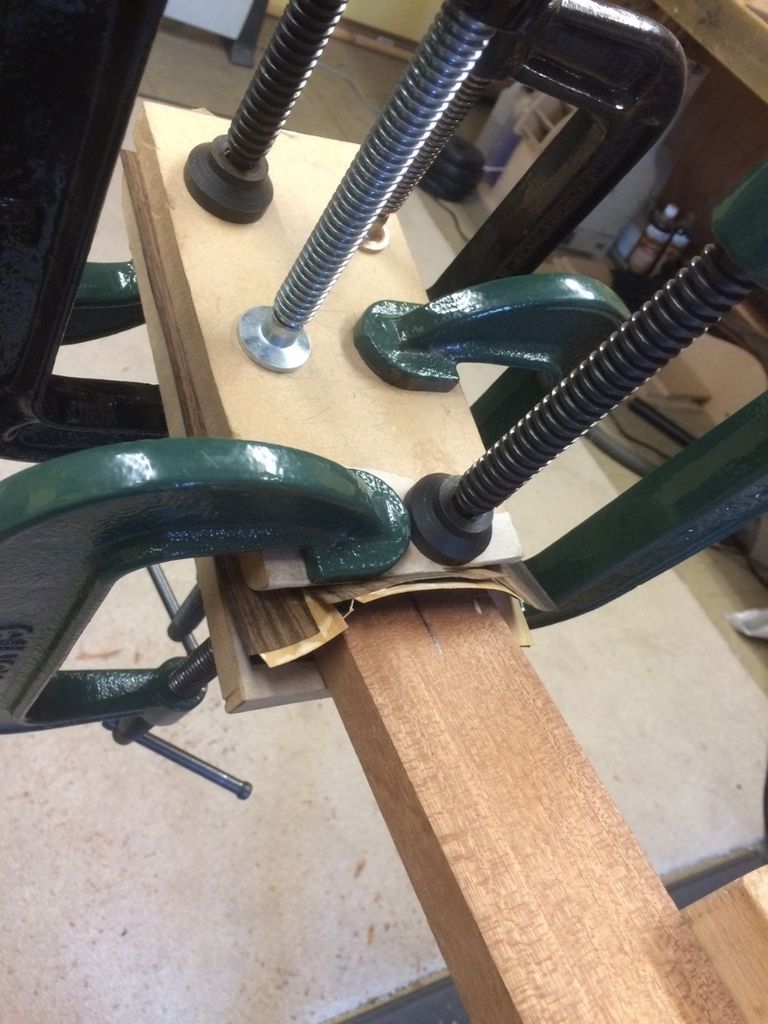 And on a slightly separate note, I am really excited to share with you all as my first announcement that I have been invited to exhibit at this year's Holy Grail Guitar show in Berlin in October! I can't wait! |
|
|
|
Post by earthbalm on Mar 23, 2016 19:09:20 GMT
And on a slightly separate note, I am really excited to share with you all as my first announcement that I have been invited to exhibit at this year's Holy Grail Guitar show in Berlin in October! I can't wait! Congratulations! I'd be interested to hear how the bracing affects the tone. |
|
R the F
Luthier / Guitar Maker
Posts: 1,135  My main instrument is: bandsaw
My main instrument is: bandsaw
|
Post by R the F on Mar 23, 2016 22:59:06 GMT
Blimey! I hope you supply a mirror with your guitars so that they can see the effort you've put into it. I should leave one without a back for the Holy Grail show; should draw a crowd.
|
|
|
|
Post by RosieTGC on Mar 26, 2016 12:04:00 GMT
Hi earthbalm , in general terms, the bracing affects tone because as well as providing the much needed structural support for a very thin soundboard under high string tension, they also help to distribute the vibrations delivered into the bridge from the strings around the rest of the soundboard. The way braces are shaped, their proportions and their densities will denote how these vibrations travel through them and into the soundboard and will therefore affect the overall tone emitted. The skill of all makers is to find a formula that works for them to excite the soundboard as much as possible, keep it structurally in tact and deliver the desired tone. It's quite a lot to consider when you think about it! |
|
|
|
Post by earthbalm on Mar 27, 2016 23:38:22 GMT
Thanks for the reply. I hope you won't mind answering another question. How will the bracing specific to this guitar shape the tone?
Dale
|
|
|
|
Post by RosieTGC on Mar 29, 2016 9:42:32 GMT
Thanks for the reply. I hope you won't mind answering another question. How will the bracing specific to this guitar shape the tone? Dale Hi earthbalm , No problem at all! There is a fair amount of detail in why each brace is shaped exactly the way that it is, but I will try to explain what I am trying to achieve with the tone overall. Also just to add an important point here too that this is just one piece of the tone puzzle and there are many other aspects to the guitar build that can affect the tone as well. So as briefly explained in my first bracing post, there is specific bracing on the treble side of the lower bout that has been designed to optimize treble frequencies. You see the bracing is light, but there is more of it and it is relatively high and some of the braces are made out of hardwood. The general point of doing all this is to make this area of the soundboard a bit more rigid. This increased rigidity, but done in a carefully considered way, is implemented with the hope of obtaining nice clear and defined treble tones. There is a fair amount of detail about why increased rigidity done in this way would achieve this, but the basics are derived from the physical principles of higher frequency sound waves, sound vibration and how these waves travels through materials. On the bass side the bracing is very light because if you imagine a drum skin (although appreciate vibration excitation in drums is slightly different) - to a certain extent - the bigger the surface area is and the more it is allowed to move, the deeper and more sustained the vibrations will become, so the hope with this side is to achieve well rounded, long sustaining bass. Obviously when any string is excited the whole soundboard will vibrate, you can’t tell the guitar which side of the soundboard to direct its energy to, but you can to a certain extent manipulate what resonates on it. The aim of having these defined areas is to manipulate as much as is possible the desired tone of the guitar, so to answer your question in the most long-winded way ever, the aim of this bracing is to be able to change it around depending on what the player wants! You can tailor it to be a brighter guitar or a bassier guitar depending on who it is built for and what type of music might be played on it. This one in particular is a show stock model so I am trialing a few new things to see the results, but overall it aims to be as balanced as possible with nice long sustaining bass, but crisp, clear trebles to match. Again though, I can’t emphasize enough how this is just one piece of a much larger puzzle! But I hope that goes to answer your question a little way. |
|
francis
C.O.G. 
Posts: 2,483  My main instrument is: Whatever I'm building...
My main instrument is: Whatever I'm building...
|
Post by francis on Mar 29, 2016 14:37:55 GMT
Individual strings will vibrate at a range of frequencies depending on where they are fretted. The guitar (as a system) will gather those vibrations but your bracing acts as a filter. Stiffer braces will carry the higher frequency oscillations across the soundboard whilst the more flexible braces will transfer the lower frequencies. Bracing is only one aspect - I've just recently used a 3 piece saddle and found that I get better bass/treble separation - perhaps a 6 piece saddle... I think the older Levin guitars had individual saddle pieces?
Superb workmanship by the way - great thread. Francis
|
|
|
|
Post by earthbalm on Mar 29, 2016 18:15:24 GMT
Thanks RosieTGC for your detailed explanation and @francis for the additional information. Cheers, Dale |
|
|
|
Post by RosieTGC on Apr 4, 2016 14:22:57 GMT
Here’s the latest build update! In my last build post you saw the veneers being stuck down to the back, I am pleased to say that they went down successfully. Here’s how it looks now with the volute roughly carved out into the neck. The veneer is striped Ebony which will hopefully compliment the Ebony back and sides nicely. 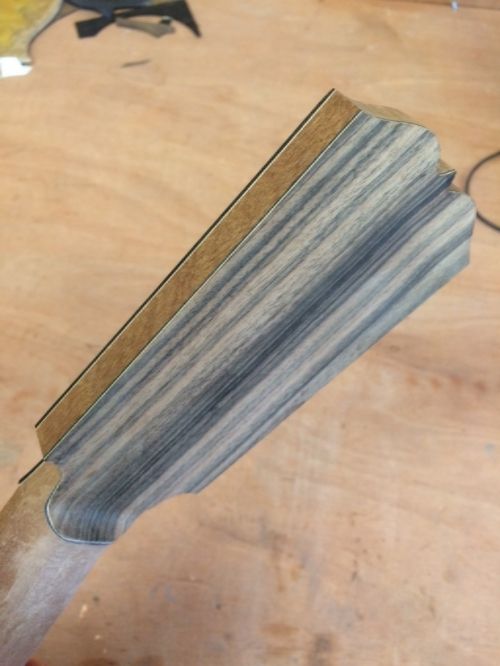 The veneers on the front have also now been stuck down. The headstock ‘motif’ on all of my guitars is the carved out bird (to replicate the Turnstone bird) and that’s now been carved out too. It still requires some final smoothing and sanding, but here it is so far. 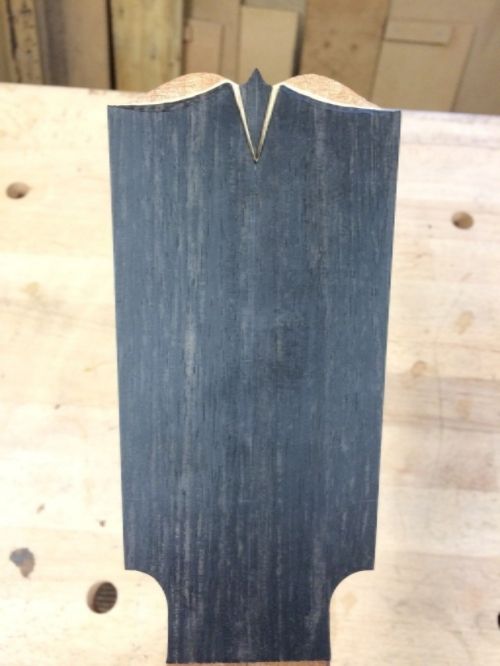 Moving back to the body, the body blocks have now been prepared. Both are made of Mahogany and the dovetail in the top block has been cut out by hand with a saw and chisel. The curvature of the body where the sides meet the blocks has also been shaped in, as you can hopefully see in the picture. 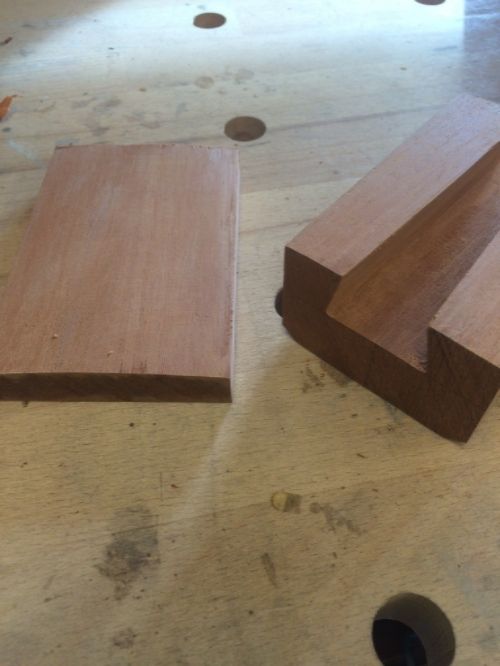 I don’t use an external or internal mold to build my guitars (hence the very clear lines maintained on the braced side of my back) so the blocks are stuck down directly to the back. To ensure the blocks protrude up exactly 90 degrees from the back, the angle of the blocks most correctly correlate to the back radius. This is done using a square held on the flat surface to the blocks whilst they are in the radius dish and the correct angle is carved in. Then they are stuck down to the back. 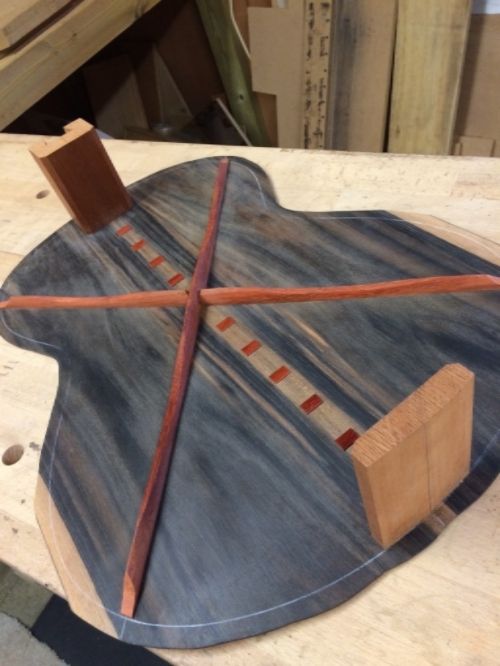 Then comes the creation of what I use the attach the top and back to the sides – the tantilons. Once again I have stuck with Padauk timber to match the back bracing and approximately 40 are required for each side, top and bottom – so that’s 160 in total. They are all cut to the exact same dimensions and are square and true. Each one is sanded on each side to make the end grain nice and clean. Let it be known that I ensure I have a good podcast to listen to during this activity….but I think the results are worth it – I look forward to showing you when they’re down. 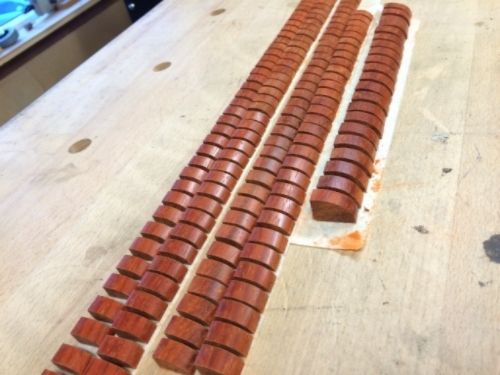 This guitar is slightly different, as you will see I have about 20 bigger ones there too. That’s because this guitar will have a ‘Wingert’ roundover arm bevel – designed by North American Luthier Kathy Wingert. She has kindly allowed me to attempt her roundover so I hope to do it justice! The roundover will mean that the binding will protrude further into the soundboard so the bigger tantilons are required. That's all for now! Back soon. |
|
|
|
Post by earthbalm on Apr 4, 2016 15:05:10 GMT
'Tis all looking fantastic, I particularly love the headstock, front and back. I'm looking forward to seeing the Kathy Wingert style bevel.
|
|
Phil Taylor
C.O.G. 
Posts: 4,516
Mini-Profile Name Color: 680908
Mini-Profile Text Color: 121311
|
Post by Phil Taylor on Apr 4, 2016 15:40:59 GMT
Here’s the latest build update! In my last build post you saw the veneers being stuck down to the back, I am pleased to say that they went down successfully. Here’s how it looks now with the volute roughly carved out into the neck. The veneer is striped Ebony which will hopefully compliment the Ebony back and sides nicely.  The veneers on the front have also now been stuck down. The headstock ‘motif’ on all of my guitars is the carved out bird (to replicate the Turnstone bird) and that’s now been carved out too. It still requires some final smoothing and sanding, but here it is so far.  Moving back to the body, the body blocks have now been prepared. Both are made of Mahogany and the dovetail in the top block has been cut out by hand with a saw and chisel. The curvature of the body where the sides meet the blocks has also been shaped in, as you can hopefully see in the picture.  I don’t use an external or internal mold to build my guitars (hence the very clear lines maintained on the braced side of my back) so the blocks are stuck down directly to the back. To ensure the blocks protrude up exactly 90 degrees from the back, the angle of the blocks most correctly correlate to the back radius. This is done using a square held on the flat surface to the blocks whilst they are in the radius dish and the correct angle is carved in. Then they are stuck down to the back.  Then comes the creation of what I use the attach the top and back to the sides – the tantilons. Once again I have stuck with Padauk timber to match the back bracing and approximately 40 are required for each side, top and bottom – so that’s 160 in total. They are all cut to the exact same dimensions and are square and true. Each one is sanded on each side to make the end grain nice and clean. Let it be known that I ensure I have a good podcast to listen to during this activity….but I think the results are worth it – I look forward to showing you when they’re down.  This guitar is slightly different, as you will see I have about 20 bigger ones there too. That’s because this guitar will have a ‘Wingert’ roundover arm bevel – designed by North American Luthier Kathy Wingert. She has kindly allowed me to attempt her roundover so I hope to do it justice! The roundover will mean that the binding will protrude further into the soundboard so the bigger tantilons are required. That's all for now! Back soon. Lovely, distinctive looking guitar Rosie - There is a chance I may see your guitars at Haydock Park in May. Phil |
|
leoroberts
C.O.G. 

Posts: 26,145  My main instrument is: probably needing new strings
My main instrument is: probably needing new strings
|
Post by leoroberts on Apr 4, 2016 21:50:01 GMT
All very interesting, Rosie ... but the BIG question is: What podcast do you listen to? Mike Harding Folk Show? No Such Thing As A Fish? Infinite Monkey Cage?  |
|
|
|
Post by RosieTGC on Apr 5, 2016 10:00:53 GMT
Lovely, distinctive looking guitar Rosie - There is a chance I may see your guitars at Haydock Park in May. Phil Hi Phil Taylor, yes you certainly can! Please stop by to say hi and try out some of the guitars! I look forward to hopefully seeing you there. |
|
|
|
Post by RosieTGC on Apr 5, 2016 10:07:50 GMT
All very interesting, Rosie ... but the BIG question is: What podcast do you listen to? Mike Harding Folk Show? No Such Thing As A Fish? Infinite Monkey Cage?  That is an important question Leo. I'm very much into the first series of 'Serial' at the moment. A true life re-investigation into a murder case that happened back in the 90's. Is the convicted guy innocent?? Is he guilty?? I'm just over half way through and it could swing either way at this stage! |
|